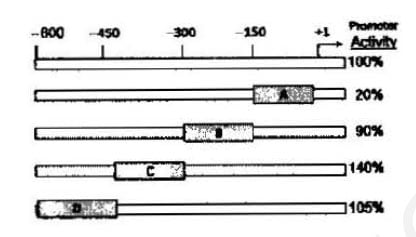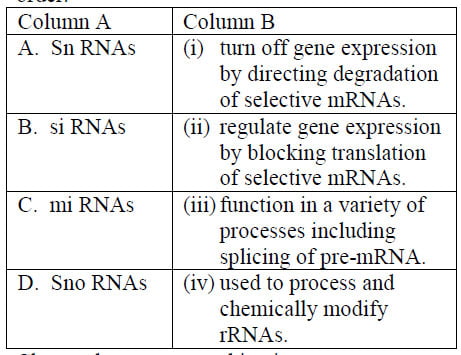Dear Students,
Welcome to Molecular Biology MCQ-13 (Molecular Biology CSIR NET). This MCQ set consists of Advanced (Post Graduate Level) Molecular Biology Multiple Choice Questions with Answer Key. All these questions were taken from the previous year question papers of CSIR JRF NET Life Sciences Examination. These questions can be used for the preparation of Competitive examinations in Biology / Life Sciences such as CSIR JRF NET, ICMR JRF, DBT BET JRF, GATE and other University Ph.D Entrance Examinations. After marking your answers, please click ‘SUBMIT‘ button to see your ‘SCORE‘ and ‘CORRECT ANSWERS‘.
You may also like: Molecular Biology Notes | Molecular Biology PPT
(1). Chromosome organization becomes clear from a series of biochemical, electron microscopic and X-ray crystallographic studies. When interphase chromatin is isolated in low salt buffer and observed under EM, 11 nm bead on string organization is seen. Interphase chromatin directly observed under EM shows 30 nm fibre. When histones are depleted from metaphase, chromosome and visualized under EM, it shows a huge number of very large loops associated with scaffold.
Following interpretations can be made from these:
(A). 11 nm fibre is formed when nucleosomes are brought closer by scaffold
(B). 30 nm interphase chromatin is formed by ziz-zag organization of nucleosomes of 11 nm fibre.
(C). 30 nm fibre makes a solenoid packing to form the metaphase chromosome
(D). 30 nm fibre gets organized into loops due to SARs getting associated with scaffold proteins and coming closer.
The correct combination of interpretations is: (CSIR_2015_I)
(a). (A) and (D)
(b). (A) and (C)
(c). (A) and (B)
(d). (B) and (D)
(2). Aminoacyl-tRNA synthetase are very specific for aminoacylation of tRNAs with the correct cognate amino acids. However, there is a possibility of a mismatch between the tRNA and its cognate amino acid. This error is corrected by the inherent proof reading activity of the aminoacyl-tRNA synthetase. In case of two very similar amino acids, namely valine and isoleucine, isoleucyl-tRNA sythetase employs the following possible approaches for an error-free aminoacylation.
(A). It removes an incorrect amino acid by hydrolyzing the aminoacyl-AMP linkage following the first reaction step
(B). It is activated for proof-reading activity, leading to breakage of the bond between the wrong amino acid and tRNA
(C). It has an intrinsic ability to recognize the structural difference between amino acids leading to abortive elimination of the non-cognate amino acid.
(D). It gets sequestered in the second step with the wrong amino acid, and that freezes the aminoacylation process.
Which of the following combinations is correct? (CSIR_2015_I)
(a). (A) and (B)
(b). (A) and (D)
(c). (B) and (D)
(d). (C) and (D)
(3). Attenuation is a mechanism involved in the regulation of tryptophan operon in E.coli. When tryptophan levels are high in the cell, region 2 of the trpL is blocked from pairing with region 3. This allows the pairing of region 3 and 4 leading to the formation of a rho-independent terminator. What would be the structure of the trpL region in E.coli cells when protein synthesis has been inhibited? (CSIR_2015_I)
(a). Region 2 pairs with region 3 allowing transcription of the structural genes
(b). Region 1 and 2 will pair, allowing 3 and 4 to pair leading to attenuation
(c). There is no pairing in the trpL region and transcription of structural gene occurs
(d). Region 2 and 3 will pair leading to attenuation
(4). MicroRNAs (miRNAs) have recently been shown to play a significant role in the fine tuning of gene expression. Some miRNAs induce gene silencing by binding to mRNAs and inducing inhibition of translation. On the other hand there are miRNAs that bind to mRNAs and activate their degradation. The following characteristics can be applicable to the miRNAs that inhibit mRNA translation.
(A). miRNA is partially complementary to a region of target mRNA in the 3’ UTR.
(B). miRNA always base pairs with mRNA around a AU rich sequence.
(C). miRNA base pairs with mRNA through 6-7 nucleotides at its 5’ end referred to as “seed sequence” as well as few additional bases elsewhere
(D). miRNA is always partially complementary to the 5’ UTR of the target miRNA.
Choose the correct options from the following: (CSIR_2015_I)
(a). (A) and (B)
(b). (A) and (C)
(c). (C) and (D)
(d). (A) and (D)
(5). The following statements are made on DNA replication:
(A). Replication form is a branched point in a replication ‘eye’ or ‘bubble’.
(B). A replication bubble contains two replication forks
(C). DNA replication is continuous according to the interpretation make by Okazaki
(D). Multiple priming events are required for both leading and lagging strands to initiate DNA synthesis.
Which one of the following is the correct combination? (CSIR_2015_I)
(a). (A) and (B)
(b). (B) and (C)
(c). (C) and (D)
(d). (A) and (C)
(6). In order to identify the regulatory regions of a novel promoter sequence shown below, four 150 bp deletion constructs were made in a luciferase reporter system as indicated in the diagram as boxes A to D. After transfection, the observed level of promoter activity (%) as analyzed by luciferase assay for all the constructs is indicated in the right of the figure. Identify the best construct combination of regions in the options given below that indicate the presence of a positive and a negative regulatory element, respectively. (CSIR_2015_I)

(a). (B) and (D)
(b). (A) and (C)
(c). (A) and (D)
(d). (A) and (B)
(7). The following statements have been proposed for a cancer cell.
(A). Binding of p53 with MDM2, a ubiquitin E3 ligase, is a precondition for cancer progression
(B). Phosphorylation of a tyrosine residue in the C-terminus of human c-Src is essential for cell invasion and motility
(C). Loss of function of both alleles of a tumor suppressor gene prevents metastasis
(D). Dimerization of c-myc-Max leads to enhanced cell proliferation
Which of the combinations of the above statements is correct? (CSIR_2015_I)
(a). (A) and (B)
(b). (C) and (D)
(c). (A) and (D)
(d). (B) and (C)
(8). A hypothetical gene encodes a protein whith the following amino acid sequence:
Phe-Pro-Thr-Ala-Val-Arg-Ser
A mutation of single nucleotide alters the amino acid sequence to:
Phe-Leu-Leu-Leu-Leu-Val
A second single nucleotide mutation occurs in same gene restoring back the amino acid sequence to the original
The following statements were made regarding the nature and location of the first mutation and that of the intragenic suppressor mutation:
(A). The first mutation is a deletion in the second codon
(B). The frist mutation is an insertion in the second codon
(C). The intragenic suppressor mutation is an insertion in the second codon
(D). The intragenic suppressor mutation is a deletion in the third codon
Which combination of the above statements is correct? (CSIR_2015_I)
(a). (A) and (C)
(b). (A) and (D)
(c). (B) and (C)
(d). (B) and (D)
(9). Enlisted below are different types of RNAs produced in the cell (Column A) and their functions (Column B), but not in the same order.

Choose the correct combination (CSIR_2015_II)
(a). A-(iv), B-(ii), C-(i), D-(iii)
(b). A-(iii), B-(i), C-(ii), D-(iv)
(c). A-(iv), B-(i), C-(ii), D-(iii)
(d). A-(iii), B-(ii), C-(i), D-(iv)
(10). In prokaryotes, the initiatior t-RNA is first charged with a methionine, followed by the addition of a formyl group to the methionine by the enzyme Met-tRNA transformylase. Given below are several statements in this context.
(A). All prokaryotic proteins have formyl methionine at their amino-terminal end.
(B). Deformylase removes the formyl group from the amino terminal methionine.
(C). All prokaryotic proteins have methionine at their amino terminal end.
(D). Aminopeptidases often remove the amino terminal methionine.
(E). Aminopeptidases remove amino terminal formyl methionine.
Which of the above statement(s) are most likely to be true? (CSIR_2015_II)
(a). A only
(b). B and C
(c). E only
(d). B and D
Answer Key
(1). Ans. (d). (B) and (D)
(2). Ans. (a). (A) and (B)
(3). Ans. (d). Region 2 and 3 will pair leading to attenuation
(4). Ans. (b). (A) and (C)
(5). Ans. (a). (A) and (B)
(6). Ans. (b). (A) and (C)
(7). Ans. (c). (A) and (D)
(8). Ans. (c). (B) and (C)
(9). Ans. (b). A-(iii), B-(i), C-(ii), D-(iv)
(10). Ans. (d). B and D
